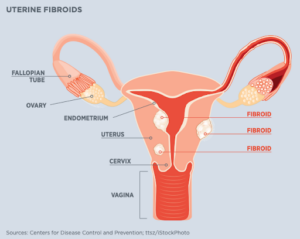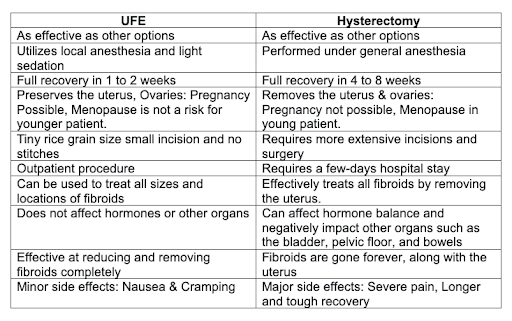Proudly Part of Privia Health
UFE For Uterine Fibroids
Myths & Mysteries about Uterine fibroid embolization (UFE)
What are uterine fibroids?
A uterine fibroid (leiomyoma) is a benign (not cancer) growth in the uterus that can alter a woman’s quality of life in many different ways. These fibroid tumors do not spread to other regions of the body, as with other cancer, and are typically not dangerous. At best they behave like a Benign Nuisance. Due to hormonal inspired growth, they consume extra blood flow from uterine arteries.

What are the symptoms of uterine fibroids?
Various symptomatic uterine fibroids cause Pelvic Pain, Severe Cramps, Pelvic pressure, Heavy menstrual bleeding, Altered Menstrual periods, Abdominal enlargement, Pain during or following intercourse, Constipation, A bloated feeling, An urge to urinate frequently, Pain down the back of one or both legs, etc.
How uterine fibroid diagnose?
Usually, patients are made aware of uterine fibroid after undergoing Pelvic Ultrasound. A magnetic resonance imaging (MRI) scan of the patient’s pelvis can help the radiologist rule out other potential causes of the symptoms and determine whether the patient is a good candidate for embolization.
Is Uterine Fibroid embolization (UFE) and Uterine Artery Embolization (UAE) the same?
Yes, UFE is a Famous common misnomer.
Is uterine artery embolization a minimally invasive procedure?
Yes. Unlike invasive surgery, Dr. Patel, an experienced Interventional Radiologist, performs an image-guided outpatient procedure avoiding surgery while preserving your uterus & ovaries, controlling symptoms, and significantly improving your quality of life. Isn’t this amazing? Approximately 9 out of 10 women who undergo uterine fibroid embolization will experience significant symptomatic fibroids improvement.
Who is a good candidate for uterine fibroid embolization?
Patients who are experiencing symptomatic fibroids such as Pelvic pain, Pelvic cramps Vaginal Bleeding, and heavy bleeding lead to low blood count, and recurrent symptoms, where typically conservative treatments are failing. This is a minimally invasive alternative to major surgery like a hysterectomy. Patients with large fibroids who underwent UFE procedures can benefit.
How does Dr. Patel (Interventional Radiologist (IR)) treat uterine fibroids?
Fibroids require a blood supply (for oxygen and nutrients) via the uterine artery to continue to grow. Without it, some or all of the tumors will die.
Under X-ray guidance and sedation, Dr. Patel will access the artery through a small incision in the wrist or groin. Dr. Patel then guides a very thin catheter (about the size of a strand of spaghetti) into the incision and through your blood vessels to the uterine artery supplying blood to the fibroid.
Once the catheter is in the proper position, the doctor releases small particles (like tiny sand granules) at the targeted location to block the small vessels and deprive the fibroid of nutrients shrinking the fibroid. Uterine artery embolization is performed in both uterine arteries. At the completion of the embolization procedure, pressure is applied to the small incision to allow it to heal.
Outpatient Procedure, you’ll be sent home with oral pain medication.
Is uterine fibroid embolization safe?
You’ll often have better results over time. Various particles are used in embolization on uterine fibroids. These drugs have long served as safe and effective medicines.
What are the incidence and risk factors for fibroid?
Fibroids are very common, 3 out of 4 women will develop fibroids during their lifetimes. Women aged 30-50, Black Women, Mothers with fibroid, an Unbalanced diet, and High Blood pressure are the most common risk factors. Research has shown that uterine fibroids will affect 70 percent of white women and 80 percent of Black women in the U.S. by the time they are 50 years old.
What happens to fibroids after uterine fibroid embolization?
As the blood supply shrinks, the fibroid tissue will begin shrinking and softening over time and in the following months. Within six months, symptoms should significantly improve.
How long does it take to recover from uterine fibroid embolization?
Many women are able to resume their normal daily activities within 7 to 10 days of their surgery.
What are the side effects of uterine artery embolization?
Much less frequent & less severe than a Hysterectomy. Possible complications are abnormal bleeding, Infections of the uterus, and Irreparable damage to an artery. A collection of blood beneath a skin surface (hematomas) on a punctured area of the groin. Most of them are self-limited and easily manageable.
How long does it take for fibroids to shrink after embolization?
Some women find relief during their menstrual cycles and others have waited more than 3 months for their symptomatic Improvement.
What kind of follow-up care is typical after uterine fibroid embolization?
Patient follow-ups are 2 weeks, 2 months, 6 months, and 1 year after the procedure.
Will I still get my period after uterine fibroid embolization?
Most women still get their periods after UFE, only much lighter. Of women over 40, about half of them stop having periods.
PREGNANCY after uterine fibroid embolization?
UFE is not recommended if you are planning to get pregnant. There is a small amount of evidence that suggests a slightly higher miscarriage rate if you have a UFE. It is certainly possible to have a normal pregnancy, normal delivery, and a normal baby after having the procedure. However, if you have the option to have another treatment for your fibroids, that would be safer until further data is available about pregnancy after UFE. If a woman has been told that a hysterectomy is her only treatment option, we would be happy to discuss the possibility of UFE with her.
Is fibroid embolization better than hysterectomy?
UFE is a newer, faster, safer, and easier way to relieve the symptoms caused by uterine fibroids, and it does not disrupt one’s life in the way a hysterectomy procedure does. Decide yourself!

